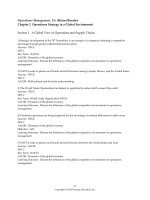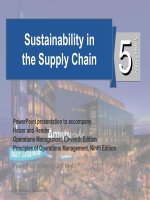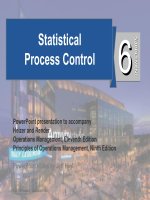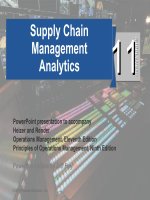Principles of operations management 9th by heizer and render module b
Bạn đang xem bản rút gọn của tài liệu. Xem và tải ngay bản đầy đủ của tài liệu tại đây (826.25 KB, 46 trang )
B
MODULE
Linear Programming
PowerPoint presentation to accompany
Heizer and Render
Operations Management, Eleventh Edition
Principles of Operations Management, Ninth Edition
PowerPoint slides by Jeff Heyl
© 2014
© 2014
Pearson
Pearson
Education,
Education,
Inc.Inc.
MB - 1
Outline
►
►
►
►
Why Use Linear Programming?
Requirements of a Linear
Programming Problem
Formulating Linear Programming
Problems
Graphical Solution to a Linear
Programming Problem
© 2014 Pearson Education, Inc.
MB - 2
Outline – Continued
▶ Sensitivity Analysis
▶ Solving Minimization Problems
▶ Linear Programming Applications
▶ The Simplex Method of LP
© 2014 Pearson Education, Inc.
MB - 3
Learning Objectives
When you complete this chapter you
should be able to:
1. Formulate linear programming models,
including an objective function and
constraints
2. Graphically solve an LP problem with
the iso-profit line method
3. Graphically solve an LP problem with
the corner-point method
© 2014 Pearson Education, Inc.
MB - 4
Learning Objectives
When you complete this chapter you
should be able to:
4. Interpret sensitivity analysis and
shadow prices
5. Construct and solve a minimization
problem
6. Formulate production-mix, diet, and
labor scheduling problems
© 2014 Pearson Education, Inc.
MB - 5
Why Use Linear Programming?
▶ A mathematical technique to help plan
and make decisions relative to the
trade-offs necessary to allocate
resources
▶ Will find the minimum or maximum
value of the objective
▶ Guarantees the optimal solution to the
model formulated
© 2014 Pearson Education, Inc.
MB - 6
LP Applications
1. Scheduling school buses to minimize total
distance traveled
2. Allocating police patrol units to high crime
areas in order to minimize response time
to 911 calls
3. Scheduling tellers at banks so that needs
are met during each hour of the day while
minimizing the total cost of labor
© 2014 Pearson Education, Inc.
MB - 7
LP Applications
4. Selecting the product mix in a factory to
make best use of machine- and laborhours available while maximizing the
firm’s profit
5. Picking blends of raw materials in feed
mills to produce finished feed
combinations at minimum costs
6. Determining the distribution system that
will minimize total shipping cost
© 2014 Pearson Education, Inc.
MB - 8
LP Applications
7. Developing a production schedule that will
satisfy future demands for a firm’s product
and at the same time minimize total
production and inventory costs
8. Allocating space for a tenant
mix in a new shopping mall
so as to maximize
revenues to the
leasing company
© 2014 Pearson Education, Inc.
MB - 9
Requirements of an
LP Problem
1. LP problems seek to maximize or
minimize some quantity (usually
profit or cost) expressed as an
objective function
2. The presence of restrictions, or
constraints, limits the degree to
which we can pursue our objective
© 2014 Pearson Education, Inc.
MB - 10
Requirements of an
LP Problem
3. There must be alternative courses of
action to choose from
4. The objective and constraints in
linear programming problems must
be expressed in terms of linear
equations or inequalities
© 2014 Pearson Education, Inc.
MB - 11
Formulating LP Problems
▶ Glickman Electronics Example
►
Two products
1. Glickman x-pod, a portable music
player
2. Glickman BlueBerry, an internetconnected color telephone
►
Determine the mix of products that will
produce the maximum profit
© 2014 Pearson Education, Inc.
MB - 12
Formulating LP Problems
TABLE B.1
Glickman Electronics Company Problem Data
HOURS REQUIRED TO PRODUCE
ONE UNIT
X-PODS (X1)
BLUEBERRYS (X2)
AVAILABLE HOURS
THIS WEEK
Electronic
4
3
240
Assembly
2
1
100
Profit per unit
$7
$5
DEPARTMENT
Decision Variables:
X1 = number of x-pods to be produced
X2 = number of BlueBerrys to be produced
© 2014 Pearson Education, Inc.
MB - 13
Formulating LP Problems
Objective Function:
Maximize Profit = $7X1 + $5X2
There are three types of constraints
►
Upper limits where the amount used is ≤ the
amount of a resource
►
Lower limits where the amount used is ≥ the
amount of the resource
►
Equalities where the amount used is = the
amount of the resource
© 2014 Pearson Education, Inc.
MB - 14
Formulating LP Problems
First Constraint:
Electronic
time used
is ≤
Electronic
time available
4X1 + 3X2 ≤ 240 (hours of electronic time)
Second Constraint:
Assembly
is
≤
time used
Assembly
time available
2X1 + 1X2 ≤ 100 (hours of assembly time)
© 2014 Pearson Education, Inc.
MB - 15
Graphical Solution
▶ Can be used when there are two decision
variables
1. Plot the constraint equations at their limits by
converting each equation to an equality
2. Identify the feasible solution space
3. Create an iso-profit line based on the
objective function
4. Move this line outwards until the optimal
point is identified
© 2014 Pearson Education, Inc.
MB - 16
Graphical Solution
X2
100 –
Number of BlueBerrys
–
80 –
Assembly (Constraint B)
–
60 –
–
40 –
–
20 –
–
|
–
0
Figure B.3
© 2014 Pearson Education, Inc.
Electronic (Constraint A)
Feasible
region
|
|
20
|
|
40
|
|
60
|
|
80
|
|
100
X1
Number of x-pods
MB - 17
Graphical Solution
X
Iso-Profit
Line Solution Method
2
100 –
Number of BlueBerrys
Choose a –possible value for the objective
function80 –
Assembly (Constraint B)
–
$210 = 7X1 + 5X2
60 –
–
Solve for
axis intercepts of the function and
40 the
–
Electronic (Constraint A)
plot the line
–
20 –
–
|–
0
Figure B.3
© 2014 Pearson Education, Inc.
Feasible
region
X = 42
X1 = 30
2
|
|
20
|
|
40
|
|
60
|
|
80
|
|
100
X1
Number of x-pods
MB - 18
Graphical Solution
X2
100 –
Number of BlueBerrys
–
80 –
–
$210 = $7X1 + $5X2
60 –
–
40 –
(0, 42)
–
(30, 0)
20 –
–
|
–
0
Figure B.4
© 2014 Pearson Education, Inc.
|
|
20
|
|
40
|
|
60
|
|
80
|
|
100
X1
Number of x-pods
MB - 19
Graphical Solution
X2
100 –
$350 = $7X1 + $5X2
Number of BlueBerrys
–
80 –
$280 = $7X1 + $5X2
–
$210 = $7X1 + $5X2
60 –
–
40 –
–
$420 = $7X1 + $5X2
20 –
–
|–
0
Figure B.5
© 2014 Pearson Education, Inc.
|
|
20
|
|
40
|
|
60
|
|
80
|
|
100
X1
Number of x-pods
MB - 20
Graphical Solution
X2
100 –
Maximum profit line
Number of BlueBerrys
–
80 –
–
Optimal solution point
(X1 = 30, X2 = 40)
60 –
–
40 –
–
$410 = $7X1 + $5X2
20 –
–
|
–
0
Figure B.6
© 2014 Pearson Education, Inc.
|
|
20
|
|
40
|
|
60
|
|
80
|
|
100
X1
Number of x-pods
MB - 21
Corner-Point Method
X2
100 –
Number of BlueBerrys
2
–
80 –
–
60 –
–
3
40 –
–
20 –
–
1
|
–
0
Figure B.7
© 2014 Pearson Education, Inc.
|
|
20
|
|
40
|
4
|
60
|
|
80
|
|
100
X1
Number of x-pods
MB - 22
Corner-Point Method
►
X2
The optimal value will always be at a corner
point 100 –
2
–
Find the80 objective
function value at each
–
corner point
and choose the one with the
–
highest60profit
–
Point 1 :
Point 2 :
Point 4 :
Number of BlueBerrys
►
–
3
40 –
(X1 = 0, X2 = 0)
Profit $7(0) + $5(0) = $0
(X
= 0, X2 = 80)
201 –
Profit $7(0) + $5(80) = $400
–
–
(X1 |= 50,
X| 2 = | 0)
|
1 –
0
Figure B.7
© 2014
© 2014
Pearson
Pearson
Education,
Education,
Inc.Inc.
20
|
40
|
4
Profit
$7(50)
+| $5(0) = $350
|
|
|
|
60
80
100
X1
Number of x-pods
MB - 23
Corner-Point Method
►
X2
The optimal value will always be at a corner
Solve
100 for
– the intersection of two constraints
point
2
–
+ 3X2 ≤function
240 (electronic
Find the804X
objective
valuetime)
at each
– 1
2X
1X2 choose
≤ 100 (assembly
corner point
the onetime)
with the
– 1 +and
highest60profit
–
Number of BlueBerrys
►
4X1–+ 3X2 = 240
4X1 + 3(40) = 240
40 –
–
4X
Point 1 :
(X11=–0,2X
X22 ==0)–200
–
Point 2 :
(X
=+0,1X
X22 ==80) 40
201 –
4X$7(0)
Profit
$5(0) =
= 240
$0
1 + +120
Point 4 :
3
X1 == $400
30
Profit $7(0) + $5(80)
–
(X1 |= 50,
X| 2 = | 0)
|
1 –
0
Figure B.7
© 2014
© 2014
Pearson
Pearson
Education,
Education,
Inc.Inc.
20
|
40
|
4
Profit
$7(50)
+| $5(0) = $350
|
|
|
|
60
80
100
X1
Number of x-pods
MB - 24
Corner-Point Method
►
X2
The optimal value will always be at a corner
point 100 –
2
–
Find the80 objective
function value at each
–
corner point
and choose the one with the
–
highest60profit
–
Point 1 :
Point 2 :
Point 4 :
Point 3 :
Figure B.7
Number of BlueBerrys
►
–
40 –
3
(X1 = 0, X2 = 0)
Profit $7(0) + $5(0) = $0
(X
= 0, X2 = 80)
201 –
Profit $7(0) + $5(80) = $400
–
–
(X1 |= 50,
X| 2 = | 0) | |
|
1 –
20 = 40)
40
(X1 0= 30, X
4
2
© 2014
© 2014
Pearson
Pearson
Education,
Education,
Inc.Inc.
Profit
$7(50)
+| $5(0) = $350
|
|
|
|
60
80
100
Profit $7(30)
+ $5(40)
Number of x-pods
X1
= $410
MB - 25









